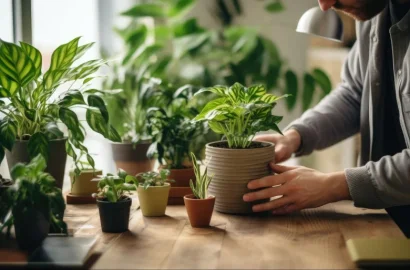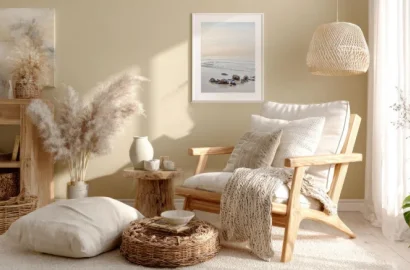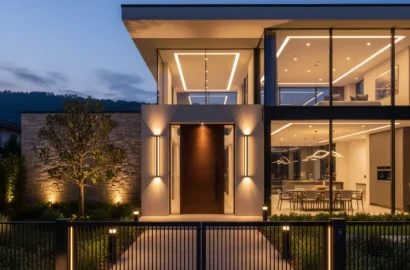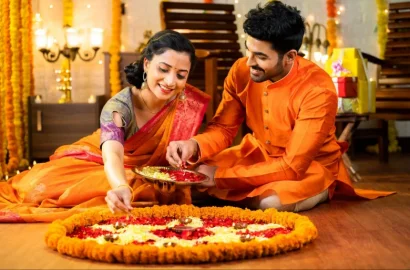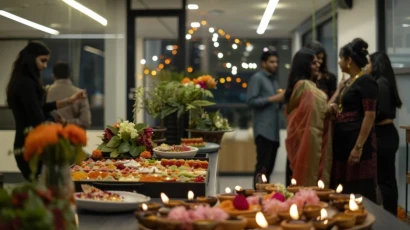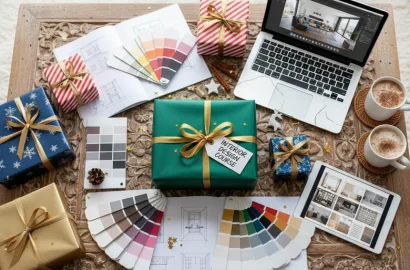Want to add a desi touch to your home? Explore the key elements of Indian interior design and ideas to implement it in your home with this carefully curated list from across the country.
When it comes to magnificent interiors that exude a sense of grandeur and vibrancy, nothing can rival the majestic allure of Indian interior design. Rooted in local cultures and lifestyles, this style embodies a fusion of diverse influences, resulting in its rich and dynamic aesthetic.
Characterised by the incorporation of opulent jewel tones, earthy hues, and striking shades such as saffron, turquoise, and crimson, Indian interiors have long been favoured in hospitality design for their vibrant and luxurious ambience. However, as its popularity continues to grow, this style is increasingly making its mark in mainstream residential design, with many individuals embracing its distinctive appeal. This guide explores the intricacies of Indian interior design, focusing particularly on Indian home interior design, and comes with actionable ideas to help you add the desi touch to your home. Read on!
Contents:
- What is Indian Interior Design?
- Key Elements of Indian Interior Design
- Examples of Indian Drawing Room Interior Design
- Examples of Indian Parallel Kitchen Interior Design
- Examples of Indian Bedroom Interior Design
What is Indian Interior Design
Indian interior design is a style of interior design that draws inspiration from the diverse cultural heritage and traditions of India. The style primarily encapsulates a rich tapestry of regional aesthetics and traditional craftsmanship. Since the style is an amalgamation of different influences, the overarching elements of Indian interior design borrow from several architectural styles across the country.
Decor elements and patterns inspired by Persian, Dravidian, Mughal and British architectural styles heavily influence the design language of such interiors and can be identified across aesthetics, showcasing cultural heterogeneity. However, the focus on creating spaces that evoke a sense of warmth, opulence, and cultural authenticity is a fundamental characteristic common across all types of Indian interior design.
Here’s a video that summarises the ideas this blog covers in detail. Watch it for insights!
Key Elements in Indian Interior Design
The use of vibrant colors, intricate patterns, luxurious fabrics, ornate furnishings, and symbolic motifs are a few key elements of Indian interior design. Here’s how these elements are reflected in a typical space designed in this style:
1. Vibrant Colours: Indian interior design often incorporates bright color palettes such as reds, oranges, yellows, and deep blues. These colours are used on walls, textiles, and furnishings to create a warm and inviting atmosphere.
2. Traditional Patterns and Motifs: Intricate patterns and traditional motifs are the hallmarks of Indian decor style. Patterns are mostly commonly seen on textiles such as rugs, carpets, tapestries and curtains, while motifs are used extensively in woodwork.
3. Natural Flooring: The Indian design style is dominated by natural materials like wood, stone, and marble. Terrazzo flooring, in particular, has been a popular choice widely incorporated in Indian households. Mud flooring is also extensively used to lend an earthy and rustic appeal.
4. Wood Furniture: Wooden furniture is one of the essential elements of the Indian design style. Indian furniture is often low to the ground and features ornate detailing. Common pieces include carved wooden chairs, low-slung sofas and daybeds, and intricately designed cabinets and chests.
5. Decorative Accents: Indian interiors are often adorned with decorative accents such as brass or copper utensils, intricately carved sculptures, and colourful artwork. Items like handwoven textiles, hand painted pottery vases, and majestic swings also adorn a traditional Indian household.

Examples of Indian Drawing Room Interior Design
1. Indian Drawing Room in Bengaluru

Source: Architectural Digest
Kaustav Dey’s Bengaluru home stands as a living testament to the warm and lively design language of Indian interior design. With the vintage wooden armchair taking centre stage, this drawing room incorporates all the primary design elements of an Indian household: rich textiles, vibrant colours, and natural materials. Throughout the space, you can see mid century wooden partitions, intricate pattachitras (cloth-based paintings), and hand-painted Kalighat artworks, creating a cohesive visual narrative. This visual homogeneity is further enhanced with a patterned rug and vibrant blue almirah, offering a contrast to the earthy aesthetic.
2. Indian Drawing Room in Bandra
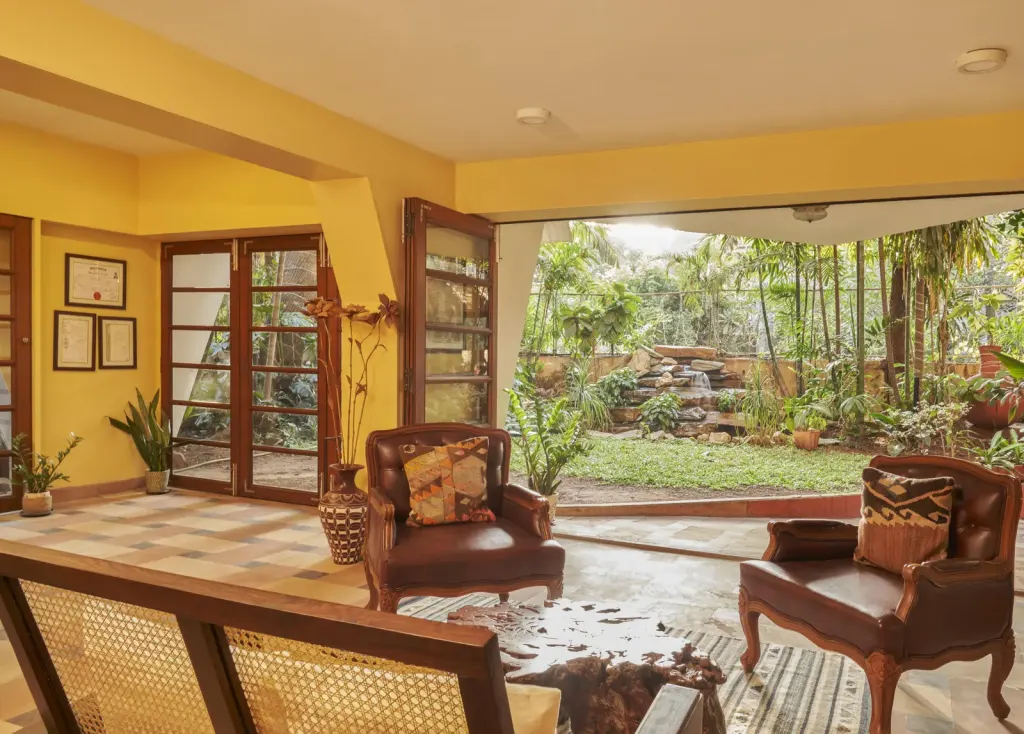
Source: Architectural Digest
Embodying the tropical Goan-Portuguese style, this house in Bandra incorporates a fusion of modern and vintage styles while staying true to the ethos of Indian interior design. The clean and uncluttered approach of modern design is balanced with mustard walls, vintage-themed flooring and majestic wooden furniture, all lending the tropical touch to the overall aesthetic. The open veranda concept seamlessly maximises the space, while pops of colours are scattered across the room through rich textile patterns, rugs, and handpainted pots.
3. Indian Drawing Room in Kozhikode
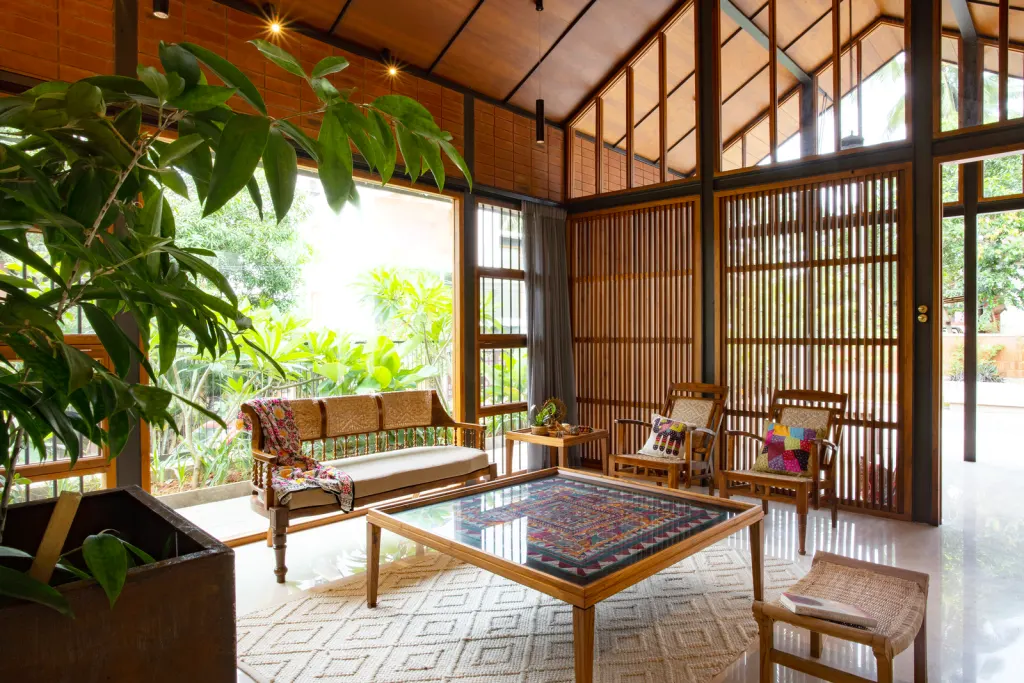
Source: Architectural Digest
While the expansive use of wood in construction has always dominated Kerala architecture, the incorporation of modern Indian interior design elements gives this Malabar home a contemporary look. The vertical sleek wooden panels function as an important source of light and air, an integral feature of Kerala homes. However, what truly lends this space an Indian coastal aesthetic is the use of teak-wood furniture accented with decorative cane weaving. This, combined with the vibrant centre table with traditional motifs adds to the Indian aesthetics of this open-concept drawing room.
4. Indian Drawing Room in Ratnagiri
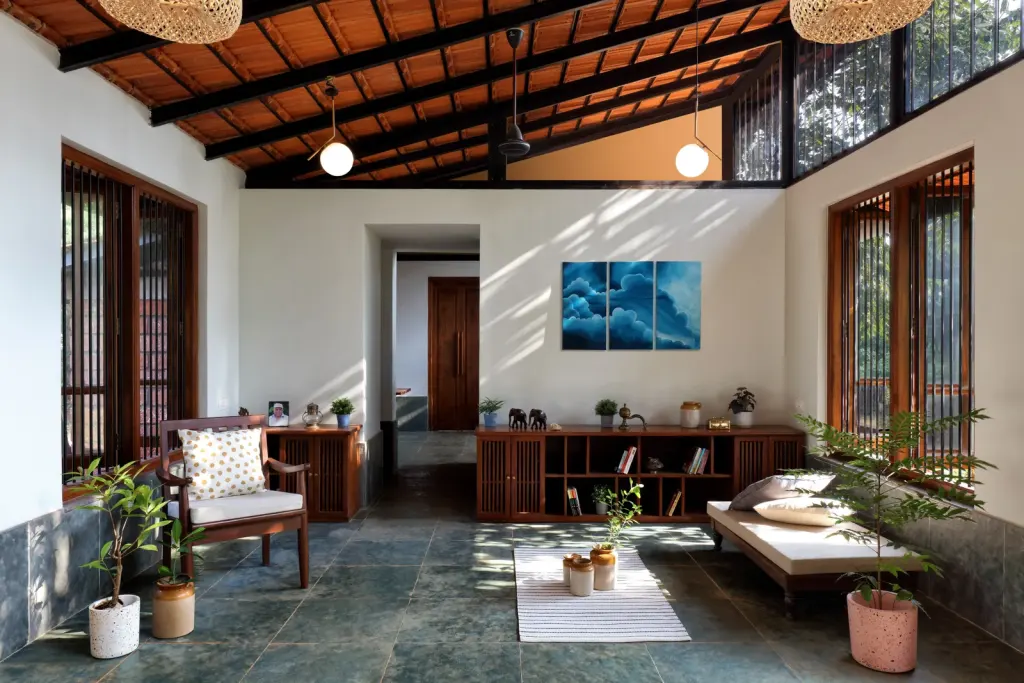
Source: Architectural Digest
A rather unique addition to the list, this drawing room embraces subtle Indian interior design elements over a foundation of contemporary decor style for a seamless blend of the modern with the traditional. To start with, the house incorporates a sloped Mangalore-tiled roof and exposed laterite walls, a core feature of most Indian homes. This Indian aesthetic is further elevated through rough Kota stone flooring, potted plants, low-height wooden day beds and teak-wood shelves. Contrasting this traditional backdrop, a neutral colour palette, clean lines, and an abstract blue contemporary painting introduce a modern sensibility to the space.
5. Indian Drawing Room in Coimbatore
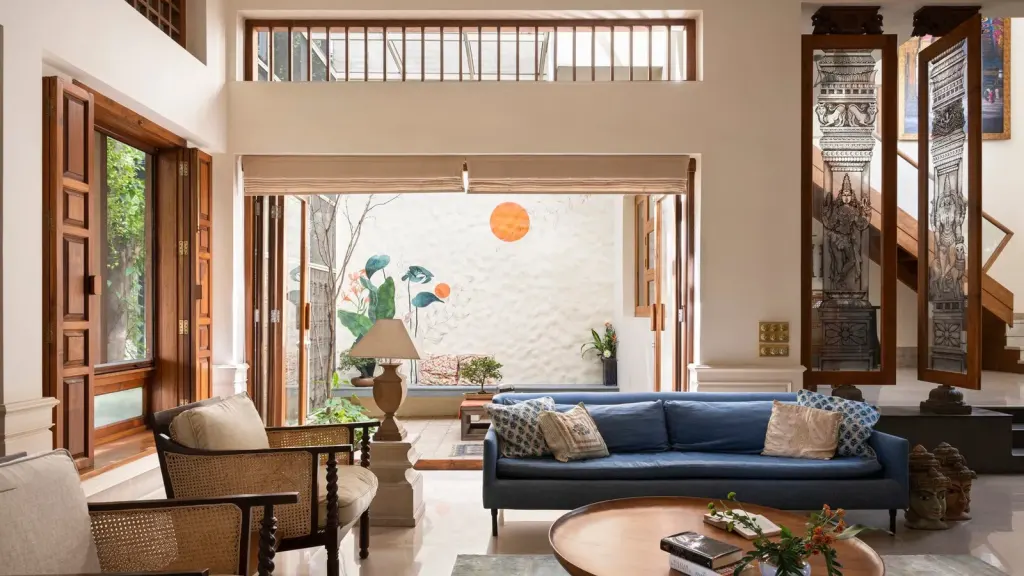
Source: Architectural Digest
The glory and magnificence of Indo-European interior design is epitomised in this traditional blend of Dravidian and British design styles. The foundation of the design language rests on traditional British wainscoting, which is then supported with Dravidian glass temple murals and cane chairs. The bright blue sofa pays homage to India’s rich colour palette, juxtaposed against the neutral backdrop of walls and Kota floors, creating a striking visual contrast. Undoubtedly, an overarching distinguishing element is the evident Chettinad influence as witnessed through the kolam marble inlay in the entrance.
6. Indian Drawing Room in Thrissur

Source: Architectural Digest
The beauty and complexity of traditional South Indian design reaches its pinnacle with this nalukettu (house divided into four blocks) in Kerala. Designed on the principles of Thachu Shastra, the drawing room integrates key design elements like a central metal swing and an open courtyard that invites natural light and ventilation. Adding a touch of vibrancy are the brick-red kolam printed tiles, skillfully juxtaposed against the teak rafters adorned with intricate wood carvings. The space exudes warmth and character, with high pillars providing structural support and a traditional painting that graces the backdrop.
Examples of Indian Parallel Kitchen Interior Design
1. Indian Parallel Kitchen in Trivandrum
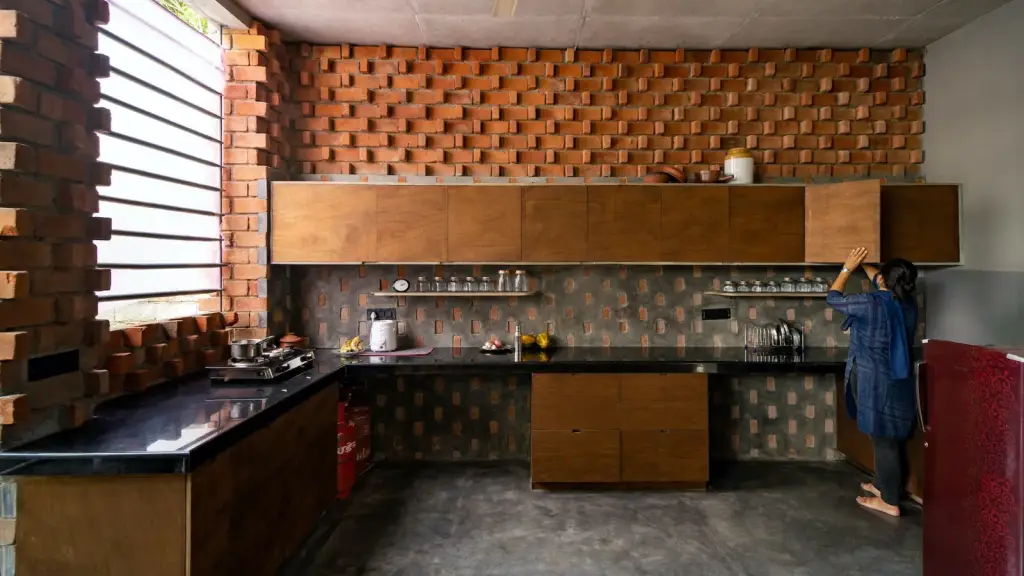
Source: Architectural Digest
Reimagining the conventional perception of Indian interior design, this kitchen in Trivandrum showcases the versatility of the aesthetic with a focus on simplicity and functionality. The design embraces a minimalist approach anchored by perforated brick walls and grey cement oxide floors, evoking a rustic and ethnic charm. A semi-open parallel kitchen layout enhances the functionality of the space, promoting ease of movement and efficient workflow. The space is thoughtfully adorned with spare wooden cabinetry, lending a touch of warmth and natural texture to the environment.
2. Indian Parallel Kitchen in Koottickal
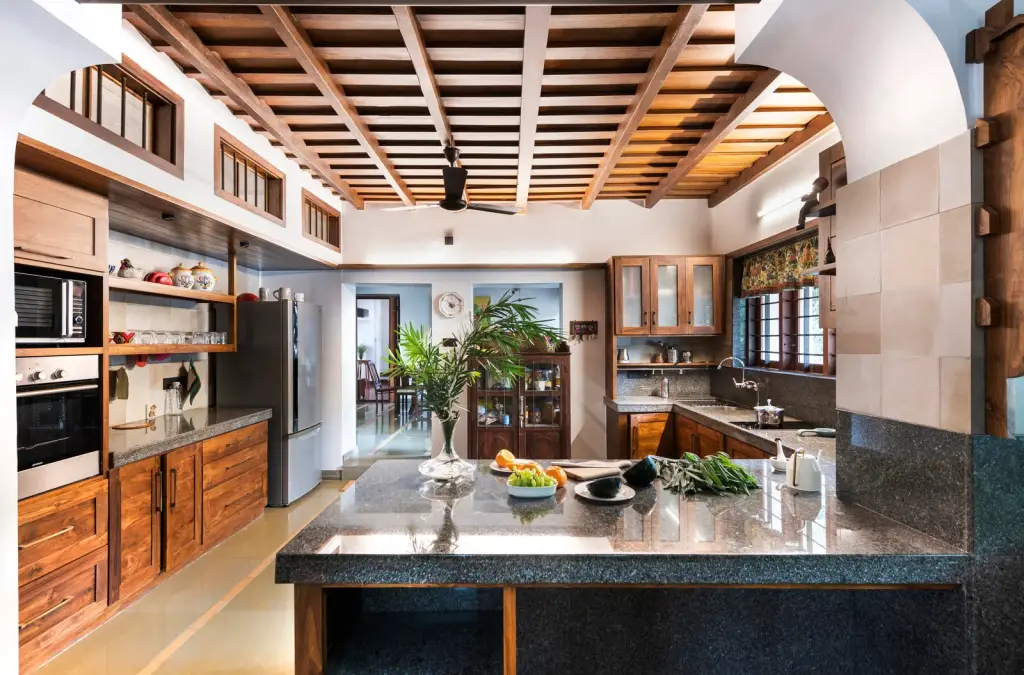
Source: Architectural Digest
Built originally in the 1950s, the authentic design of this house was constructed for an affluent Christian family. Elements of British architecture heavily influenced the basic foundation of the design language of this Indian parallel kitchen. Eclectic ceiling pattern is a dominantly British design element you will find fused in the Indian context here through the use of teakwood. Other visible Indian elements include the use of polished limestone flooring, granite countertops and arches for a dome-like effect. Last but not least, additional teakwood storage and retention of original 1950s Kerala-style windows give the kitchen its unique Indian identity.
3. Indian Parallel Kitchen in Kerala

Source: DesignCafe
Featuring a rustic wooden finish with intricate patterns and cravings, this kitchen highlights the extensive importance wood carvings play in Indian interior design and decor. Celebrating a parallel kitchen layout, the design theme takes a break from terrazzo floorings and utilises mosaic tiles. The open ceiling for ventilation and natural light and the semi-dome cavity framed in rich wood stand as the epitome of modern Indian parallel kitchen design.
4. Indian Parallel Kitchen in Haryana

Source: Project Markat by Studio Crypt
Blending the distinct design styles of Kutch, Jodhpur, Bastar, Shantiniketan, and Patiala, Project Markat by Studio Crypt stands out for its authentically Indian style. Unlike other entries on the list, this design is characterised by a fusion of regional cultures, evident in the diverse motifs and patterns adorning the kitchen cabinets. Another standout feature of this parallel kitchen design is the use of hand-painted cabinets in vibrant hues and terrazzo kitchen tops, staying true to the essence of Indian interior design.
5. Indian Kitchen in Kerala
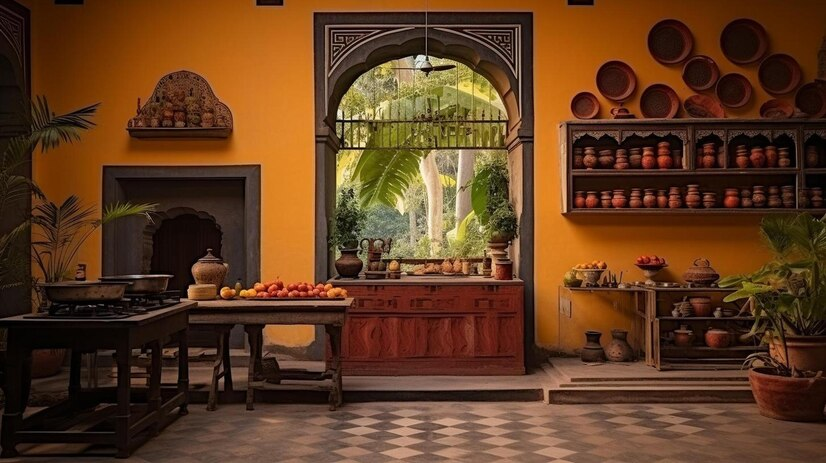
Source: FreePik
While diverging from the traditional parallel kitchen design, the distinctively Indian aesthetic of this kitchen arrangement warrants inclusion in the list. The focal point of the overall space is undoubtedly the vibrant mustard colour scheme and intricately crafted wooden arches. Elaborate wooden shelves adorned with terracotta pots, along with patterned marble flooring, contribute to the earthy allure of the space. Ultimately, the abundant use of wooden accents, adorned with motifs and patterns, imbues the environment with an unmistakable desi charm.
6. Indian Parallel Kitchen in Tamil Nadu
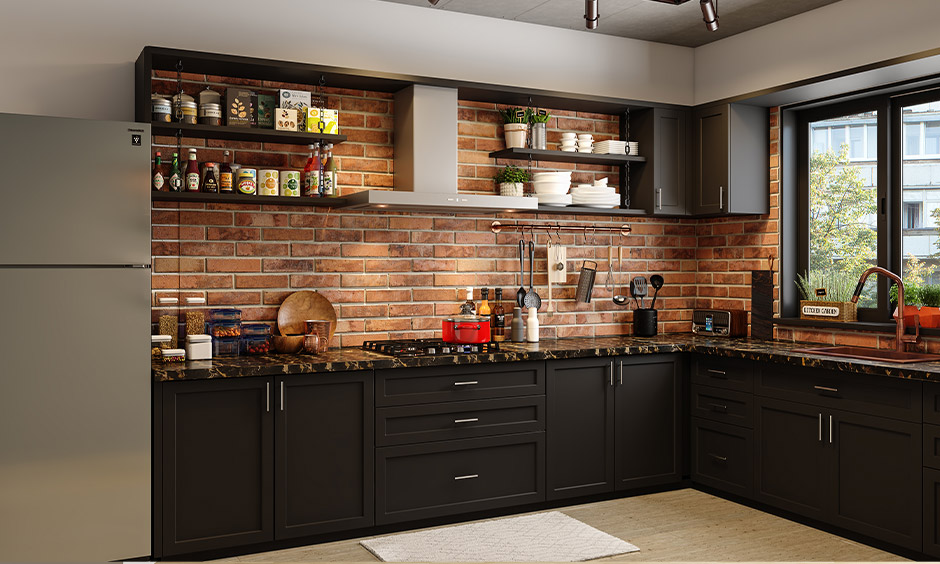
Source: Pinterest
An Indian kitchen design wouldn’t be complete without the distinctive touch of extensive brickwork. This parallel kitchen design effortlessly combines the practicality of modern kitchens with the rich aesthetics of Indian culture. The striking feature of the expansive brickwork on the wall instantly commands attention. While the sleek design of the backend shelves may deviate from traditional Indian elements, it harmonises beautifully with the commonly used granite marble kitchen top.
Examples of Indian Bedroom Interior Design
1. Indian Bedroom in Haryana

Source: Kamath Design Studio
Revathi Kamath has been a pioneer in promoting Indian design, particularly through her groundbreaking work on earth architecture. This magnificent bedroom in Haryana stands as a prime example of authentic and traditional Indian interior design. Taking inspiration from Persian arches, the bedroom design incorporates a semi-dome window, mud walls painted in deep mustard and patterned tile flooring. The Bohemian-styled chair along with other design accents like mud lamps, handmade pottery, a wooden shelf and a circular bed add a contemporary touch to this rather traditional bedroom.
2. Indian Bedroom in Kochi
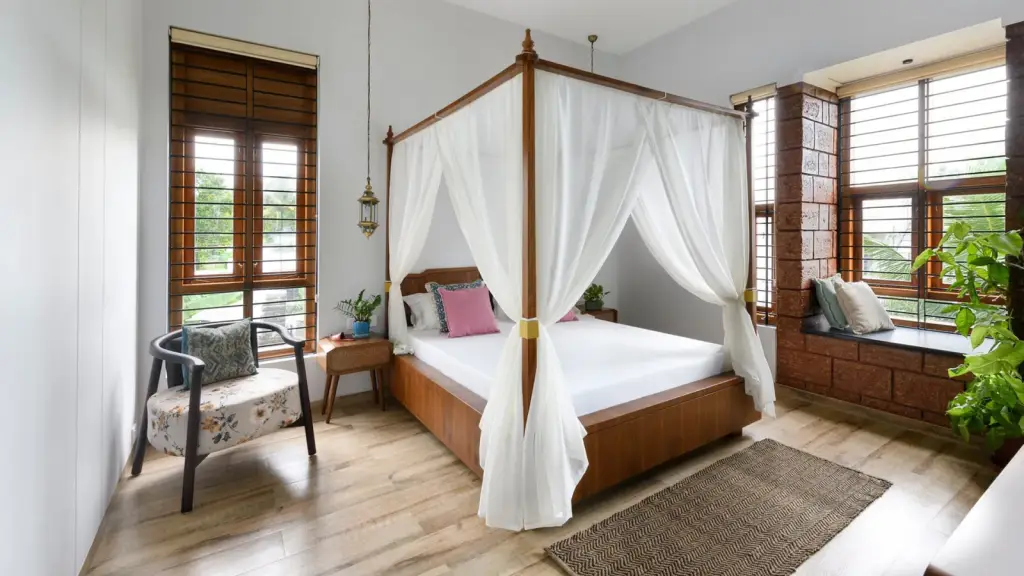
Source: Architectural Digest
Drawing inspiration solely from regional textures and palettes, this Mumbai-based bedroom design deviates from the typical earthy and vibrant approach, instead prioritising the creation of a tranquil space. By incorporating local materials such as Cheru teak wood, glass panels, and white-curtained canopy beds, the design infuses a sense of freshness. Pops of colours through printed cushion covers break over the neutrality of the space. This juxtaposed against ancient terracotta tiles and bay windows adorned with bricked walls truly embodies a refreshing perspective on Indian interior design.
3. Indian Bedroom in Kelwa
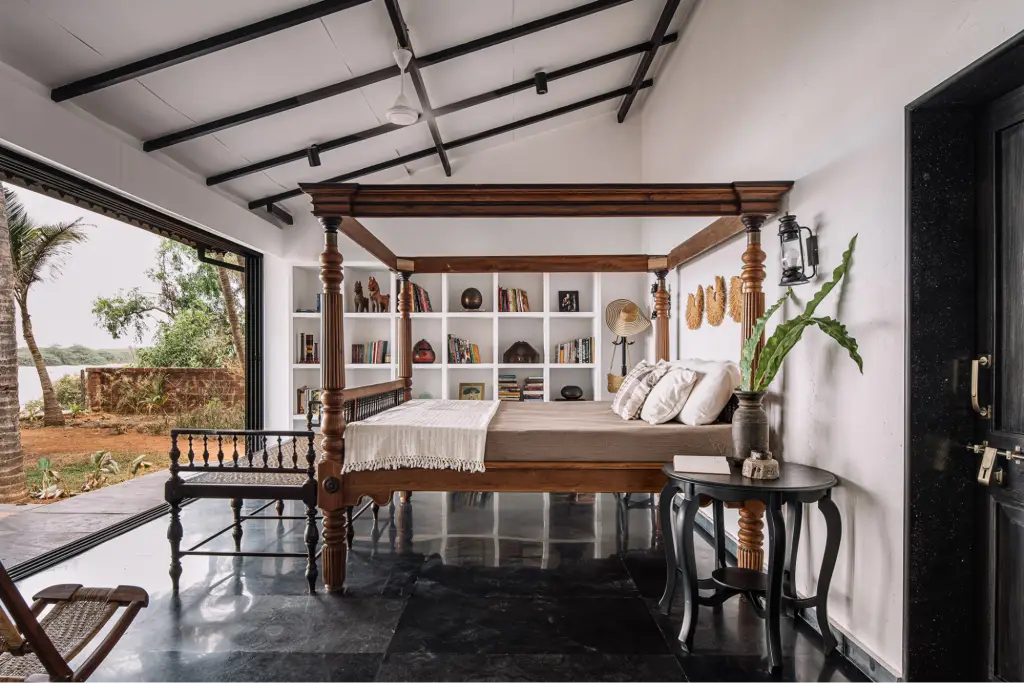
Source: Architectural Digest
Amritha Karnakar’s renovation of this coastal house undeniably epitomises bohemian-inspired Indian interior design. Crocheted bed covers and cotton cushions, set against the open window, serve as unmistakable Bohemian elements that embellish the room. However, despite the prominent Bohemian influence, the space firmly embraces its Indian roots with a traditional canopy bed positioned at the centre. The sleek wooden daybed adorned with intricate carvings and the cane chair in the corner are authentic Indian design elements that, set against the backdrop of marble flooring and other decor accents, imbue the room with a coastal Indian bedroom aesthetic.
4. Indian Bedroom in Mumbai
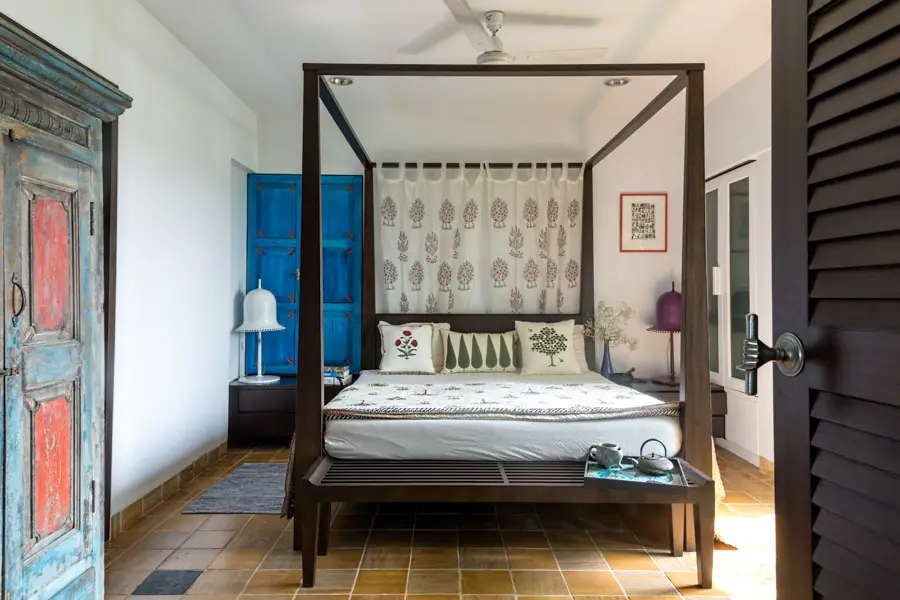
Source: The Light Cube Photography
Block prints, grand motifs, and rich textiles have long been at the core of Indian interior design. Drawing inspiration from local textile traditions such as Bagru prints, Bandhej dots, and Phulkari cushion covers, this bedroom design is rooted in the vibrant confluence of regional cultures. The textile language employed encompasses a diverse array of prints and motifs, ranging from lotuses and leaves to peacocks, creating a tapestry of rich desi ambience. Against the backdrop of terracotta mosaic tile flooring, the wooden bed canopy and vibrant blue almirah serve to further accentuate the opulence of Indian design ethos.
5. Indian Bedroom in Coorg

Source: Beautiful Homes
Warm, earthy hues of orange, brick red and beige can never go wrong in this context, as exemplified by this authentically Indian bedroom design. The opulent woodwork of the bed canopy reflects Persian design influences, while the minimalist slatted headboard adds modern simplicity. Terracotta-coloured upholstery and Mughal cushion prints introduce rich cultural motifs against a neutral backdrop of white tiled flooring. Wooden furniture and large paintings further enhance the opulent essence of the design, adding richness and depth to the space.
6. Indian Bedroom in Haryana

Source: Studio Crypt
Belonging to the rich Marakat project of Studio Crypt, this Indian bedroom design brings to the forefront the amalgamation of different regional cultures. Particularly standing out is the emerald green wooden furniture used with a variation of coral that signifies the inherent meaning of Marakat: harmony and balance. Set against mosaic tiles and a neutral palette, this bedroom incorporates antique furniture in the form of a bed canopy, an intricately designed mirror and a side table. All these decor elements are tied together through subtle hues of orange and printed bed covers and curtains.
How To Get Started with Indian Interior Design
Getting started with Indian interior design involves understanding the rich cultural heritage and diverse aesthetic traditions of India. Here are a few ways you can go about it:
Research and Inspiration: The best way to get started with Indian interior design is by familiarising yourself with different styles, colours, patterns, textures, and motifs commonly found in Indian interiors. Books, magazines, online videos, documentaries and social media are a few resources that can go a long way here.
Understand Cultural Significance: The fundamentals of Indian interior design are closely rooted in the ideas of balance, harmony, spirituality, and connection to nature, all of which are found in the Indian design philosophy. It is, therefore, important to explore the cultural significance and symbolism behind different facets of this Interior design style.
Incorporate Indian Design Elements: Another resourceful way of learning the intricacies of Indian interior design is by experimenting with it in your personal space. Personalise your space with Indian-inspired decor items like brass or copper utensils, intricately carved wooden figurines, ornate lamps, and hand-painted pottery.
Acquire a formal qualification: Enrolling in a course relevant to the industry is among the most effective methods to develop expertise in Indian interior design. Formal courses in Interior Design can train learners in essential aspects like different furniture styles, cultural influences, and space layout, while providing a deeper understanding of symmetry, proportion, and the overall visual balance of space in the Indian context.
Seek guidance from professionals: Collaborating with experienced architects or interior designers specialising in Indian interior spaces can infuse expertise and creativity into your design process. Participating in workshops, boot camps, or studying the works of recognised industry leaders are also effective ways to seek inspiration.
Develop a relevant portfolio: An interior design portfolio serves as a visual representation of your design approach and capabilities. A design portfolio should ideally incorporate the design research, process and final designs to give hiring managers a holistic view of your approach. You can draw inspiration from this Residential Interior Design Project by AND learner Nandini Nagarajan for building your portfolio.
Next Steps
We hope our guide on Indian interior design could inspire the creative genius within you.
In case you need further assistance, here are some resources to consider:
- Watch this session by Snehanshu Mukherjee, Founding Partner at T.E.A.M and Mansi Almadi, an Interior Designer at Studio Lotus
- Talk to a course advisor to discuss how you can transform your career with one of our courses.
- Check out our Interior Design courses – all courses are taught through live, interactive classes by industry experts.
- Take advantage of our scholarship and funding options to overcome any financial hurdle on the path of your career transformation.
Note: All information and/or data from external sources is believed to be accurate as of the date of publication.



